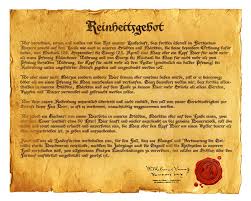 Saturday is a big day in the beer world. Okay, maybe not St. Patrick’s Day big or Super Bowl big, but for beer fans who appreciate history and quality, It is a pretty big day. April 23, 2016 marks the 500th anniversary of the passing of the Reinheitsgebot, the German Beer Purity Law. Five hundred years is a long time for a law to be on the books (it was 400 years before Canadian women even had the right to vote, so think of that).
Saturday is a big day in the beer world. Okay, maybe not St. Patrick’s Day big or Super Bowl big, but for beer fans who appreciate history and quality, It is a pretty big day. April 23, 2016 marks the 500th anniversary of the passing of the Reinheitsgebot, the German Beer Purity Law. Five hundred years is a long time for a law to be on the books (it was 400 years before Canadian women even had the right to vote, so think of that).
In honour of the occasion I did something I don’t normally do. I devoted every single one of my beer columns to the topic of the Reinheitsgebot, its history and its signficance today. You can read the Vue Weekly, Planet S or Beer 101 versions. Or, better yet, you can listen to a streaming of my CBC column. (It didn’t hurt they were all due to run in the course of a few days just before the anniversary.)
I try to do two things in the columns. First, I try to offer a correct history of the law. The broad strokes are well known – that it restricted ingredients for beer to water, barley and hops. However, there are lesser known aspects to its origins. For example, the Bavarian version passed in 1516 was not the first beer purity law in Germany. That honour goes to Munich way back in 1484. Also, it was not the law for all of Germany until unification under the Weimar Republic in 1918. I will sidestep the whole government-Catholic church-hop grower conspiracy to drive out pagan ingredients.
Second, and more importantly, I discuss why it still matters today. Sure it force as a law was substantially undermined by the European Union (thanks, Fischer!), and given the modern craft beer revolution its restrictive tenets make it seem rather quaint, stodgy and anachronistic. Why restrict yourself to malt, water and hops (and yeast – but that goes without saying, really) when there is a whole world of interesting ingredients to make interesting beer. From coffee to fruit, pumpkins to chili peppers, oysters to juniper – literally every edible creation is at least potentially an interesting flavour addition. Also, its clumsy efforts at regulation beer (which was a very good thing, by the way – who wants henbane or soot in their beer?), have been supplanted by a much more rigourous regulatory regime.
Allow me to rise to the defence of the Reinheitsgebot. I argue that it is more important today than it was 50 years ago. It may have lost most of its legal force, but it possesses a powerful moral authority over the beer world, especially among lagers. Craft beer companies and their pseudo-competitors scramble to see who can make the sturdiest claim of being Reinheitsgebot-compliant. Today the Reinheitsgebot is a marker of “quality” in beer.
But it is more than that. The Reinheitsgebot is also a symbol of an ethic in brewing. Being true to your ingredients, using only processes that can be justified as being good for the beer and, first and foremost, putting quality first. I think that ethos pervades the craft beer movement, regardless of which ingredients they opt to use.
I am well aware you can make bad beer with only barley, water and hops, and in that respect you can argue it is specious to link the Reinheitsgebot to quality. But I counter by saying, look around. The quality of beer has never been higher in the history of the great beverage. There are many reasons for that (science, ingredients, knowledge of micro-organisms that spoil beer), but I argue the Reinheitsgebot ranks up there. It started us on a course, saying to brewers they had to up their game to survive. And 500 years later we continue on that path.
So this weekend raise a pint for the Reinheitsgebot! It sure looks good for its age.

Leave a Reply